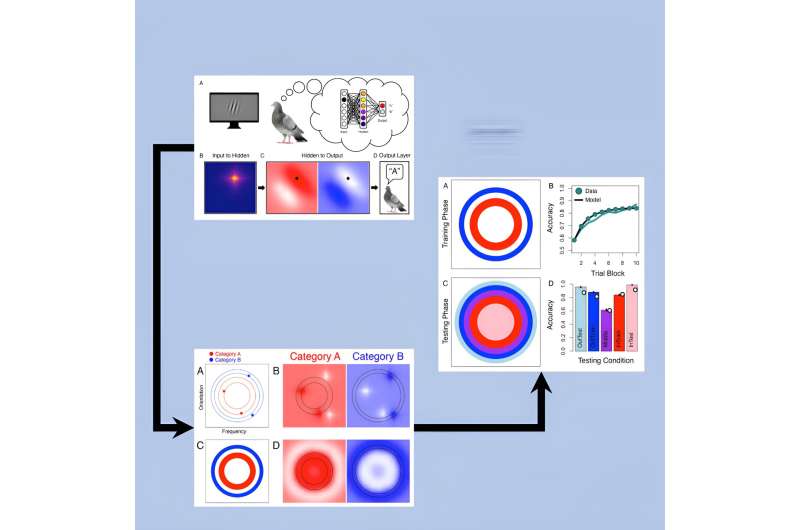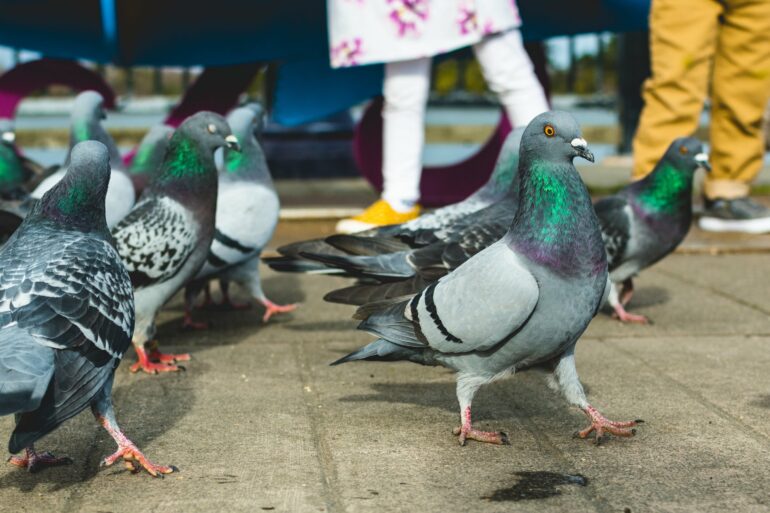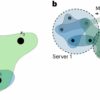A new study provides evidence that pigeons tackle some problems just as artificial intelligence would—allowing them to solve difficult tasks that would vex humans.
Previous research had shown pigeons learned how to solve complex categorization tasks that human ways of thinking—like selective attention and explicit rule use—would not be useful in solving.
Researchers had theorized that pigeons used a “brute force” method of solving problems that is similar to what is used in AI models, said Brandon Turner, lead author of the new study and professor of psychology at The Ohio State University.
But this study may have proven it: Turner and a colleague tested a simple AI model to see if it could solve the problems in the way they thought pigeons did—and it worked.
“We found really strong evidence that the mechanisms guiding pigeon learning are remarkably similar to the same principles that guide modern machine learning and AI techniques,” Turner said.
“Our findings suggest that in the pigeon, nature may have found a way to make an incredibly efficient learner that has no ability to generalize or extrapolate like humans would.”
Turner conducted the study with Edward Wasserman, a professor of psychology at the University of Iowa. Their results were published recently in the journal iScience.

© iScience (2023). DOI: 10.1016/j.isci.2023.107998
In the study, pigeons were shown a stimulus, which could include lines of various widths and angles, concentric rings and sectioned rings. They had to peck a button on the right or left to indicate to which category it belonged to. If they got it correct, they received a food pellet—if they were wrong, they received nothing.
There were four different tasks in the study, some harder than the others. Results showed that, through trial and error, the pigeons improved their ability to make the correct choices in one of the easier experiments from about 55% to 95% of the time. Even in a more difficult scenario, their correct responses improved from 55% to 68%.
Researchers believed the pigeons used what is called associative learning, which is linking two phenomena with each other. For example, it is easy to understand the link between “water” and “wet.” People teach their dogs to link sitting when they are commanded with receiving a treat.
But those associations are relatively easy.
“Associative learning is frequently presumed to be far too primitive and rigid to explain complex visual categorization like what we saw the pigeons do,” Turner said.
But that’s exactly what the researchers found.
The researchers’ AI model tackled the same tasks using just the two simple mechanisms that pigeons were presumed to use: associative learning and error correction. And, like the pigeons, the AI model learned to make the right predictions to significantly increase the number of correct answers.
For humans, the challenge when given tasks like those given to pigeons is that they would try to come up with a rule or rules that could make the task easier.
“But in this case, there were no rules that could help make this any easier. That really frustrates humans and they often give up on tasks like this,” he said.
“Pigeons don’t try to make rules. They just use this brute force way of trial and error and associative learning and in some specific types of tasks that helps them perform better than humans.”
What’s interesting, though, is that pigeons use this method of learning that is very similar to AI designed by humans, Turner said.
“We celebrate how smart we are that we designed artificial intelligence, at the same time we disparage pigeons as dim-witted animals,” he said.
“But the learning principles that guide the behaviors of these AI machines are pretty similar to what pigeons use.”
More information:
Brandon M. Turner et al, The pigeon as a machine: Complex category structures can be acquired by a simple associative model, iScience (2023). DOI: 10.1016/j.isci.2023.107998
Provided by
The Ohio State University
Citation:
‘Dim-witted’ pigeons use the same principles as AI to solve tasks, study shows (2023, October 25)



